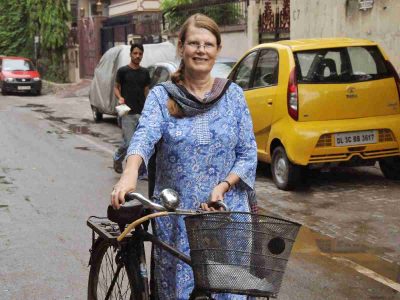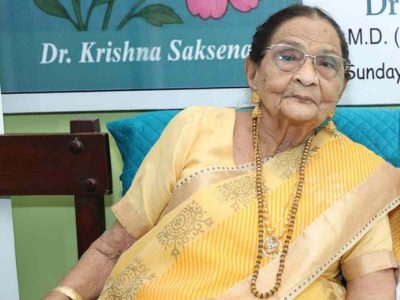Transgenders led by Lakshmi Narayan Tripathi found their place in the 14 akharas of the Kumbh Mela this time, making her an instant celebrity
Acharya Mahamandaleshwar of Kinnar (transgender) Akhara is the most recent entrant into the 14 akharas. She created history by leading hundreds of transgenders to take dip in the holy Sangam on Makar Sankranti for the first time in many hundred years. This happened despite the opposition of the Akhil Bhartiya Akhara Parishad, as Juna Akhara came to their rescue.
For transgenders, it was a question of acceptability of their existence, their rights, privileges and religious role in society accorded to them in Sanathan Dharam (orthodox Hinduism), a concept which till recently was almost forgotten.

Lakshmi Narayan Tripathi looks like a queen in her gaudy saree, bright makeup, red luminescent lips, thick eyeliner, all emphasising her larger than life persona. She’s sharp and witty, she remembers people and faces, is multilingual, and speaks English with a flourish. She’s a celebrity, perhaps the most talked about personality at the Kumbh Mela, more than any sage or sadhu.
She meets hundreds of people every day, some believe she has healing powers. They touch her feet and seek her blessings. She’s welcoming, gives an honest hearing, pecks on the forehead, and a coin as a token of her blessings. That coin becomes the most prized possession for many.
There’s media, there are curious people, there are followers, there are bouncers for protection, there are nirvana seekers from abroad, all present in large numbers. It’s no surprise that the Kinnar Akhara is the most guarded place in the whole of the Kumbh township. Though located slightly away from the other akharas, almost isolated, its significance is not diminished.
An interview:
Do you feel this is a historic moment for the kinnar community in India, for that matter all over the world?
As per the Sanatan Dharam, kinnars have a special place, the ancient sacred texts describing us as demi-gods.
It was none other than Lord Ram who blessed the kinnars on his return to Ayodhya for their devotion towards him. But here, we were never part of Akhara culture as we were considered sub-humans. Actually, we are the true followers of Sanatan Dharam. We are not beggars, we seek our right to get religious freedom just like any other human being.
Has the recent Supreme Court judgement removing section 377 helped the kinnar community…
No one has the right and the power to intrude into our religious freedom when the Constitution does not discriminate against us. The recent ruling of the Supreme Court gives us protection and more rights in society. Many members of the transgender community were living in fear or were shy, now feel empowered to speak up.
This has been a fight for existence…
I’m not fighting anyone. I’m asking for my rights, my place in the Hindu religion. We weren’t even considered human. Bhrantiya (delusions) never end. Things changed when we took a bath in the holy Ganges here in Kumbh Mela. It want to say to everyone: Please come to Kumbh Mela, don’t just watch it on your television.
When did you first think of forming the Kinnar Akhara?
The idea was conceptualised in 2015. In 2016, we asked for land from the Mela authorities. We wanted to be part of this great event. There was opposition. Many came to help us, like Pankaj Dubey, Ashwani and many more. They call me ‘Mother’ and help our cause. There was opposition, there was politics being played, but we had the support of Juna Akhara, Hari Giri Maharaj ji who said, “Kinnar Akhara tha, hai, rahega” (was, is, shall remain).
How did it feel when you took the holy dip in Ganges?
In the Braham Murat (pre-dawn) when I took the dip, maine atma se shingaar kiya (My soul was my ornament). It felt like homecoming. Aisa laga jaise beti apne maike aayi hai pachaas saal baad. (I felt as if I’m a married daughter who returns to her mother’s home after 50 years). The Supreme Court gave us the right. I’m the Acharya Mahamandaleshwar. Only five akharas were given 40 minutes to take dip in the Ganges during Shahi snan, we were the fifth akhara. Mandir ke eenth mandir me lag gaye (The brick that belonged to temple was replaced in the temple). Kinnar were re-established in Sanathan Dharam.
Is it a dream come true?
I grew up in Mumbai. I thought the people in northern India, particularly in UP, are conservative. I was wrong. People wait for 5-6 hours to meet me, they come in large numbers to seek my blessings. How much more can you expect? We don’t force people to convert at gunpoint, Hinduism is a very inclusive religion.
Transgender Persons (Protection of Rights) Bill has been tabled in Parliament. It’s about focused approach to provide and protect rights of transgender community, also talks about creation of institutions like the national and state commissions for transgenders and special courts. Your comments.
There are problems in the bill. There is no word about traditions and social set-up of kinnars, like guru-chela parampara (like teacher-follower practice). We are not beggars, Sanathan Dharam gives us certain rights.
This bill has to approach the whole issue in the right cultural and traditional contexts. Then there’s provision of a screening committee, which is problematic. I’d say it is the starting point.
More people will come out. Support for the cause of the third gender is going to rise in future.
I agree, our strength has been increasing but it’s not a numbers game. There’s no bar — money, status, class or caste — for a transgender person to join the Kinnar Akhara. To stay away from any controversy, we carry out background verification of the person joining the Akhara.





